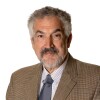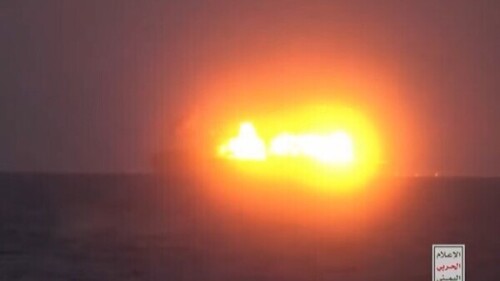We read that “Prime Minister” Mahmoud Abbas is running in the elections on Sunday to succeed Yasser Arafat as “president” of “Palestine.”
Excuse me, but prime minister, according to the Encyclopedia Britannica, means the “head of the executive branch of government in states with a parliamentary system.” Despite tens of thousands of references to Mr. Abbas as prime minister, he in not a single way fits this description.
Oh, and there is also the matter of there being no country called Palestine. Arab maps show it in place of Israel. The U.N. recognizes its existence. So too do certain telephone companies – for example, France’s Bouygues Telecom and Bell Canada. Nonetheless, no such place exists.
One can dismiss use of these terms as symptoms of the same unrealism that has undermined Palestinian Arab war efforts since 1948. But they also promote the Palestinian cause (a polite way of saying, “the destruction of Israel”) in a vital way.
In an era when the battle for public opinion has an importance that rivals the clash of soldiers, the Palestinian Arabs’ success in framing the issues has won them critical support among politicians, editorial writers, academics, street demonstrators, and NGO activists. In the aggregate, these many auxiliaries keep the Palestinian effort alive.
Especially in a long-standing dispute with a static situation on the ground, public opinion has great significance. That’s because words reflect ideas – and ideas motivate people. Weapons in themselves are inert; today, ideas inspire people to pick up arms or sacrifice their lives. Software drives hardware.
Israel is winning on the basic geographic nomenclature. The state is known in English as Israel, not the Zionist entity. Its capital is called Jerusalem, not Al-Quds. Likewise, Temple Mount and Western Wall enjoy far more currency than Al-Haram ash-Sharif or Al-Buraq. The separation barrier is more often called a security fence (keeping out Palestinian suicide bombers) than a separation wall (bringing to mind divided Berlin).
In other ways, however, the Palestinian Arabs’ wording dominates English-language usage, helping them win the war for public opinion.
- Collaborator means someone who “cooperates treasonably” and brings to mind the French and Norwegian collaborators who betrayed their countries to the Nazis. Yet this term (rather than informant, mole, or agent) universally describes those Palestinian Arabs providing Israel with information.
- Refugee status normally applies to someone who, “owing to a well-founded fear of being persecuted . . . is outside the country of his nationality,” but not to that person’s descendants. In the Palestinian case, however, children, grandchildren, and great-grandchildren of refugees also merit refugee status. One demographer estimates that more than 95% of so-called Palestinian Arab refugees never fled from anywhere. Nonetheless, the term continues to be used, implying that millions of Palestinian Arabs have a right to move to Israel.
- A settlement is defined as a small community or an establishment in a new region. Although some Jewish towns on the West Bank and in Gaza have tens of thousands of residents and have existed for nearly four decades, settlement, with its overtones of colonialism, is their nearly universal name.
- Occupied territories implies that a Palestinian state existed in 1967, when Israel captured the West Bank and Gaza. That was not the case, making these areas legally disputed territories, not occupied ones.
- Cycle of violence, a term President George W. Bush has adopted (“the cycle of violence has got to end in order for the peace process … to begin”), implies a moral equivalence between the killing of Israeli civilians and Palestinian Arab terrorists. It confuses the arsonist with the fire department.
- The peace camp in Israel – a term that derives from Lenin’s usage – refers to those on the left who believe that appeasing mortal enemies is the only way to end Palestinian aggression. Those in favor of other approaches (such as deterrence) by implication constitute the “war camp.” In fact, all Israelis are in the “peace camp” in the sense that all want to be rid of the conflict; none of them aspires to kill Palestinian Arabs, occupy Cairo, or destroy Syria.
Arabs may have fallen behind Israel in per capita income and advanced weaponry, but they lead by far on the semantic battlefield. Who, a century back, would have imagined Jews making the better soldiers and Arabs the better publicists?
West Bank: I did not discuss this term above because I do not see it as part of the Palestinian lexicographical assault. Here is why I use West Bank rather than Judea and Samaria:
The region in question came into political existence as the West Bank of Jordan and so that’s the term I use. Judea and Samaria only approximates the area defined by the West Bank. Using the term West Bank is not tantamount to adopting the Palestinian narrative but being historically precise.
To the point that United Nations Security Council Resolution 181 uses Judea and Samaria: yes, it does, but in the context of a 579-word paragraph that reads in full as follows:
The boundary of the hill country of Samaria and Judea starts on the Jordan River at the Wadi Malih south-east of Beisan and runs due west to meet the Beisan-Jericho road and then follows the western side of that road in a north-westerly direction to the junction of the boundaries of the sub-districts of Beisan, Nablus, and Jenin. From that point it follows the Nablus-Jenin sub-district boundary westwards for a distance of about three kilometres and then turns north-westwards, passing to the east of the built-up areas of the villages of Jalbun and Faqqu’a, to the boundary of the sub-districts of Jenin and Beisan at a point north-east of Nuris. Thence it proceeds first north-westwards to a point due north of the built-up area of Zir’in and then westwards to the Afula-Jenin railway, thence north-westwards along the district boundary line to the point of intersection on the Hejaz railway. From here the boundary runs south-westwards, including the built-up area and some of the land of the village of Kh.Lid in the Arab State to cross the Haifa-Jenin road at a point on the district boundary between Haifa and Samaria west of El Mansi. It follows this boundary to the southernmost point of the village of El Buteimat. From here it follows the northern and eastern boundaries of the village of Ar’ara, rejoining the Haifa-Samaria district boundary at Wadi’Ara, and thence proceeding south-south-westwards in an approximately straight line joining up with the western boundary of Qaqun to a point east of the railway line on the eastern boundary of Qaqun village. From here it runs along the railway line some distance to the east of it to a point just east of the Tulkarm railway station. Thence the boundary follows a line half-way between the railway and the Tulkarm-Qalqiliya-Jaljuliya and Ras el Ein road to a point just east of Ras el Ein station, whence it proceeds along the railway some distance to the east of it to the point on the railway line south of the junction of the Haifa-Lydda and Beit Nabala lines, whence it proceeds along the southern border of Lydda airport to its south-west corner, thence in a south-westerly direction to a point just west of the built-up area of Sarafand el’Amar, whence it turns south, passing just to the west of the built-up area of Abu el Fadil to the north-east corner of the lands of Beer Ya’Aqov. (The boundary line should be so demarcated as to allow direct access from the Arab State to the airport.) Thence the boundary line follows the western and southern boundaries of Ramle village, to the north-east corner of El Na’ana village, thence in a straight line to the southernmost point of El Barriya, along the eastern boundary of that village and the southern boundary of ‘Innaba village. Thence it turns north to follow the southern side of the Jaffa-Jerusalem road until El Qubab, whence it follows the road to the boundary of Abu Shusha. It runs along the eastern boundaries of Abu Shusha, Seidun, Hulda to the southernmost point of Hulda, thence westwards in a straight line to the north-eastern corner of Umm Kalkha, thence following the northern boundaries of Umm Kalkha, Qazaza and the northern and western boundaries of Mukhezin to the Gaza District boundary and thence runs across the village lands of El Mismiya, El Kabira, and Yasur to the southern point of intersection, which is midway between the built-up areas of Yasur and Batani Sharqi.
Aug. 13, 2012 update: Philippe Assouline offers a delicious lexicographic study of Palestinian English titled “Palestinese Lexicon,” where Palestinese refers “a parallel language … that Palestinian activists and their allies have indeed invented,” today at the Times of Israel. Here is the first entry:







